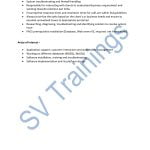
HL7 Online Training
This HL7 Certification training is completely hands-on and developed in a way to help you to become an HL7 specialist.
- PREREQUISITES
- COURSE CONTENT
- DEMO RECORDINGS
- INTERVIEW QUESTIONS
- CERTIFICATION QUESTIONS
- SAMPLE RESUMES
- FAQs
This HL7 Online Course Training program is fully online for all healthcare professionals. Learners, Candidates, Students who want to upgrade their ability in Healthcare Applications can opt for this HL7 Online Training Course. Although there are no special skills you need to start with HL7 Training, but there are few abilities that would be beneficial for you:
- Basic Computer Skills
- Integration Processes
- Knowledge Of TCP/IP
- Basic Concepts Of Healthcare Systems Used By This Industry
- Updating Databases With New Information
HL7 Course Overview
This course is for HL7 programmers, interface developers and dedicated Implementers and is
designed to provide the skills for the analysis testing, problem tracking and activation of phases of an HL7 project. Attendees will learn HL7 design, trigger concepts, message formatting rules, data types, enhanced acknowledgement rules, identifiers, and table translation issues. Course work includes hands-on exercises.
On completion of this HL7 Online course, attendees will have gained a deep understanding of HL7 messaging processes and practices, with the ability to effectively read, understand, analyse, design, develop, market and test HL7 messages.
HL7 Course Modules
Session 1 – Healthcare Messaging Standards
Session 2 – Concepts and Principles
Session 3 – 7 – Building Messages and Segments
Session 8,9 – HL7 Building Blocks (Data Types)
Best HL7 Online Training Interview Questions
Q1. What is Hl7?
Interoperability, or the back-and-forth exchange of patient health data among different organizations, is seen as the “ultimate IT goal of the modern healthcare system,” when discussing meaningful use, HITECH and the Affordable Care Act, said Brull. “One of the major challenges to healthcare interoperability is defining common standards for structured content of healthcare data and the transport of that data between different systems, created by different vendors,” he said. Creating consensus behind a common healthcare standard is the mission of HL7, which was founded in 1987. “The HL7 Standard was created and has since become widely adopted by vendors worldwide to define content,” said Brull.
Q2. What Are Z Segments?
Z segments contain clinical or patient data that may not be a good fit for other segments of the HL7 v2 standard, said Bull. Essentially, it’s used as the ‘catch all’ for data that doesn’t fit into the HL7 Standard message definitions – Z segments can be inserted into any message. They’re also one reason why the HL7 Standard is sometimes called a flexible standard, he added. There literally are no limits to the data contained in a Z segment, or in the number of Z segments included in an HL7 message,” said Bull.
Q3.What Is An Orm Message?
According to Brull, ORM messages are general order messages that contain any request for clinical materials such as, for example, 500 ml of saline, or services like an EKG study. “Order messages are usually associated with a particular patient, but they can also be used by a department to order materials,” he said. “The transmission of ORM messages occurs between the application placing the order, and the clinical application filling the order.” Typically, he added, the caregiver enters an order in the HIS application. This then acts as the “placer” application. “The system that receives the message for the HIS application is typically considered the ‘filler’ of the order,” Brull said.
Q4. What Are Hl7 Separator Characters?
“Separator characters in HL7 are also known as message delimiters or special encoding characters,” said Brull. “The separator characters are defined at the beginning of the HL7 message in the MSH segment.” An example MSH segment with the HL7-recommended separator characters would begin: MSH|^~&, with the separator characters defined as:
| (field separator, aka pipe)
^ (component separator, aka hat)
& (sub-component separator)
~ (field repeat separator)
(escape character)
“While the above separator characters are recommended, the separator character for segments, (ASCII 13 or HEX 0D), is not negotiable,” added Brull.
Q5. What Does Btahl72vxcommon Project Contain?
It contains Schema for MSH segment and HL7 acknowledgements.
Q6. Is It Mandatory To Configure Party For Hl7?
Yes, you need to add a party for each application that sends data into BizTalk server.
Q7. What Consideration Is To Be Taken While Dealing With Msh Entries?
Entries in MSH are case sensitive.
Q8. Why Is It Required To Have Party Configured?
The HL7 parser is designed to check the party configuration for each HL7 message. It reads the MSH.3 and checks for whether a party has been defined. If it has then HL7 parser follows the configuration supplied via HL7 configuration explorer.
Q9. Can We Override Values In The Msh Segment Of The Outgoing Message?
Yes, it is possible to override certain field values in MSH segment of outgoing message.
Q10. What Is The Difference Between Btahl72xreceive And Btahl7xmlreceive?
Both are used to receive HL7 message but former one used to receive HL7 message as flat file and later one to receive HL7 message as XML.
Q11. What Is The Difference Between Hl7 Version 2 And Hl7 Version 3?
According to Brull, HL7 version 3 (v3) isn’t all that similar to HL7 version 2 (v2). “While v2 provides a ‘negotiated framework’ for developers to easily use and adapt, v3 was targeted to be a stricter standard that aimed to eliminate variances, in an effort to improve interoperability between all users of the standard,” he said. From a technical standpoint, he added, typical HL7 structure data uses “pipes” (|) and “hats” (^), while HL7 v3 is based on XML. “Due to a large embedded v2 base, adoption of v3 is still very slow in the U.S., with [more than] 90 percent of systems and applications still using some form of HL7 v2,” he said. HL7 v3 includes both messages and documents, he added, with v3 documents being called CDA, or clinical document architecture. “While a move to v3 message doesn’t appear to be on the horizon, CDA documents have been adopted in meaningful use standards for both Stages 1 and 2,” Brull said.
Q12. What Is An Adt Message?
The most commonly used HL7 v2 messaging type is ADT, or admit discharge transfer messages, which record patient demographic and visit information. They’re typically initiated by the Hospital Information Systems (HIS), or a registration application, said Brull. They also “inform other connected systems about key patient information, such as [when] the patient has been admitted, discharged, transferred, or if the patient’s demographic data has changed,” such as their name, insurance, or next of kin, he said.
Q13. What Is An Oru Message?
ORUs, or observational report messages, are usually the result message from the “filler” application of the ORM message, said Brull. They typically contain information and analysis from medical procedures, like test results from the lab or the radiology department. “ORU messages also can be used for linking orders and results to clinical trials,” he added.
Q14. What Are Hl7 Escape Sequences?
HL7 defined character sequences to represent “special” characters not otherwise permitted in HL7 messages, said Brull. “These sequences begin and end with the message’s escape character – usually “” – and contain an identifying character followed by zero or more characters.” The most common use of these escape sequences, he said, is the escape the HL7 characters defined above.
Q15. What Does Btahl7231common Project Contain?
It contains the definitional schema referred to by all version 2.31 message schemas.
Q16. Is It Required To Specify Schema Per Pipeline?
Unlike default flat file DASM that BizTalk server provides, the HL7 does not require that a schema be specified per pipeline.
Q17. When Does Dasm Generate Acknowledgements?
If configured for Acknowledgement or if MSH.15 and MSH16 request them, the DASM generates one or more acknowledgements.
Q18. HL7 Accelerator Runs In Which Mode?
HL7 accelerator runs only in 32-bit mode. (64-bit support is available in BizTalk 2013).
Q19. Can We Alter The Namespace In The Msh Schema?
We can, but do not alter because the HL7 parser only looks for single MSH, the standard one that the HL7 accelerator provides.
Q20. What Are The Acknowledgement Types Defined By Hl7?
The ACK code is found in the MSA-1 field of the ACK message.
The following codes are supported by HL7:
- AA – Application Accept
- AE – Application Error
- AR – Application Reject
What Our Students Have to Say

Click edit button to change this text. Lorem ipsum dolor sit amet, consectetur adipiscing elit. Ut elit tellus, luctus nec ullamcorper mattis, pulvinar dapibus leo.
Kelvin Black

Click edit button to change this text. Lorem ipsum dolor sit amet, consectetur adipiscing elit. Ut elit tellus, luctus nec ullamcorper mattis, pulvinar dapibus leo.
Zasha Swan

Click edit button to change this text. Lorem ipsum dolor sit amet, consectetur adipiscing elit. Ut elit tellus, luctus nec ullamcorper mattis, pulvinar dapibus leo.
Frank Jones

Click edit button to change this text. Lorem ipsum dolor sit amet, consectetur adipiscing elit. Ut elit tellus, luctus nec ullamcorper mattis, pulvinar dapibus leo.

